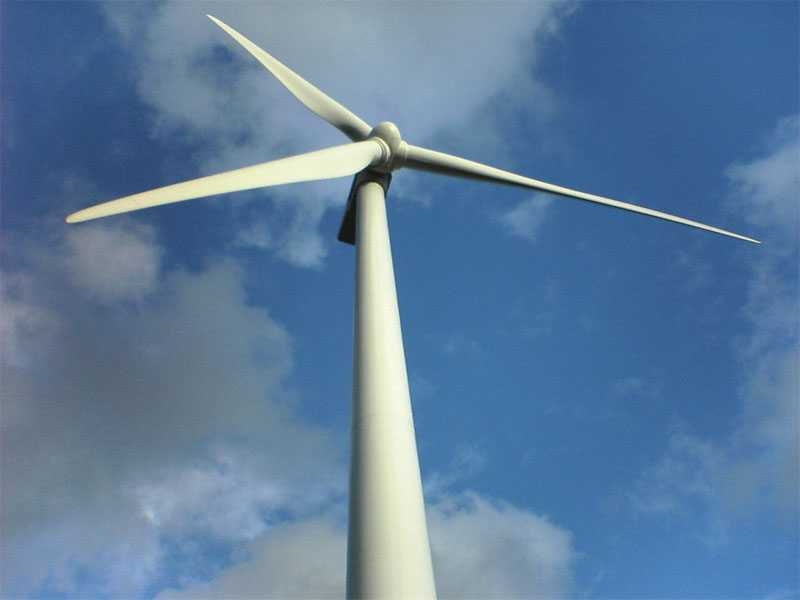MIT students and staff worked together last month to install wind-monitoring equipment on a lighting post in the west campus athletic fields to evaluate whether to erect a wind turbine there in the spring.
The planned turbine, a Skystream 3.7 with a rated output of 2.4 kilowatts, about enough to power an average home, is a gift from Philip Deutch as a tribute to his father, Institute Professor John Deutch. In addition to providing some power for the tennis bubble, the turbine would provide a teaching and research tool for MIT students. Already, the spring-semester class Projects in Energy plans to use the wind measuring equipment as part of its wind project.
But before installing the windmill, it's essential to quantify the wind resource that's available amid the many campus buildings. To do so, recording anemometers were mounted atop and at different levels on a light pole. A Lidar system, from NRG Systems, may be tested next to it. The Lidar system enables continuous monitoring of wind speeds at various levels, up to 200 meters above the ground, to determine exactly how much the wind speeds vary with height. A second monitoring station will be installed later at the far western end of the field, to provide a second set of location-specific data.
Peter Cooper, manager of sustainability engineering and utility planning for MIT's Department of Facilities, says that additional turbines might eventually be installed in other campus locations, including some building rooftops, as well as at MIT's Bates Linear Accelerator facility in Middleton, Mass. After the monitoring tower is taken down in the spring to make way for the first on-campus turbine, the tower may be set up in Middleton to begin monitoring wind speeds at that location, he says. The planned turbine "is certainly not the last wind project here, by any means," he says.
Robert Armstrong, deputy director of the MIT Energy Initiative, says that one of MITEI's four major objectives is "using the campus as a living laboratory," and having a working wind turbine on campus would help to meet that mandate.
Graduate student in engineering systems Katherine Dykes, vice-president of the MIT Energy Club and founder of the Wind Energy Group, says that wind monitoring equipment for site evaluation would usually use its own free-standing tower, but the athletics department were concerned that the guy wires needed to support such a tower would interfere with sport activities in the area. The solution was to make use of a light pole already in place.
Monitoring the wind is crucial because it's hard to predict exactly how wind will flow in a complex environment surrounded by many buildings, and even small differences in average wind speed can make a big difference. Because the energy of the wind varies as the cube of the speed, explains NRG representative Larry Jacobs, if you find a spot where the average wind speed is twice as high, the amount of power that could be generated would increase by a factor of eight.
The Lidar system that NRG has developed allows continuous monitoring of wind speeds from ground level all the way up to 200 meters, using just a box on the ground that takes up less than one cubic yard. The work is being carried out by a group of graduate students led by Dykes and Wind Energy Group president Kathy Araujo. They have been working with the Facilities Department, with MITEI's "walk the talk" program for campus energy improvements, and with donors and industry representatives.
Planning for this project, dubbed Project Full Breeze, has been underway for well over a year. Even before the eventual windmill is installed, the project has an educational function — for now, a hands-on demonstration of the equipment and procedures needed for site evaluation, as well as access to the local, real-time data being provided by that equipment. The team hopes to make that real-time data available online, so that any students can use the information for their own research projects. "Each phase is a stand-alone project that will provide information for student-related research," Dykes explains.
The planned turbine, a Skystream 3.7 with a rated output of 2.4 kilowatts, about enough to power an average home, is a gift from Philip Deutch as a tribute to his father, Institute Professor John Deutch. In addition to providing some power for the tennis bubble, the turbine would provide a teaching and research tool for MIT students. Already, the spring-semester class Projects in Energy plans to use the wind measuring equipment as part of its wind project.
But before installing the windmill, it's essential to quantify the wind resource that's available amid the many campus buildings. To do so, recording anemometers were mounted atop and at different levels on a light pole. A Lidar system, from NRG Systems, may be tested next to it. The Lidar system enables continuous monitoring of wind speeds at various levels, up to 200 meters above the ground, to determine exactly how much the wind speeds vary with height. A second monitoring station will be installed later at the far western end of the field, to provide a second set of location-specific data.
Peter Cooper, manager of sustainability engineering and utility planning for MIT's Department of Facilities, says that additional turbines might eventually be installed in other campus locations, including some building rooftops, as well as at MIT's Bates Linear Accelerator facility in Middleton, Mass. After the monitoring tower is taken down in the spring to make way for the first on-campus turbine, the tower may be set up in Middleton to begin monitoring wind speeds at that location, he says. The planned turbine "is certainly not the last wind project here, by any means," he says.
Robert Armstrong, deputy director of the MIT Energy Initiative, says that one of MITEI's four major objectives is "using the campus as a living laboratory," and having a working wind turbine on campus would help to meet that mandate.
Graduate student in engineering systems Katherine Dykes, vice-president of the MIT Energy Club and founder of the Wind Energy Group, says that wind monitoring equipment for site evaluation would usually use its own free-standing tower, but the athletics department were concerned that the guy wires needed to support such a tower would interfere with sport activities in the area. The solution was to make use of a light pole already in place.
Monitoring the wind is crucial because it's hard to predict exactly how wind will flow in a complex environment surrounded by many buildings, and even small differences in average wind speed can make a big difference. Because the energy of the wind varies as the cube of the speed, explains NRG representative Larry Jacobs, if you find a spot where the average wind speed is twice as high, the amount of power that could be generated would increase by a factor of eight.
The Lidar system that NRG has developed allows continuous monitoring of wind speeds from ground level all the way up to 200 meters, using just a box on the ground that takes up less than one cubic yard. The work is being carried out by a group of graduate students led by Dykes and Wind Energy Group president Kathy Araujo. They have been working with the Facilities Department, with MITEI's "walk the talk" program for campus energy improvements, and with donors and industry representatives.
Planning for this project, dubbed Project Full Breeze, has been underway for well over a year. Even before the eventual windmill is installed, the project has an educational function — for now, a hands-on demonstration of the equipment and procedures needed for site evaluation, as well as access to the local, real-time data being provided by that equipment. The team hopes to make that real-time data available online, so that any students can use the information for their own research projects. "Each phase is a stand-alone project that will provide information for student-related research," Dykes explains.






